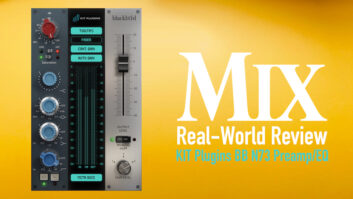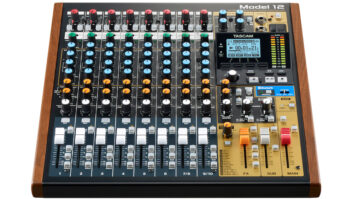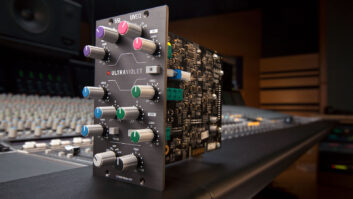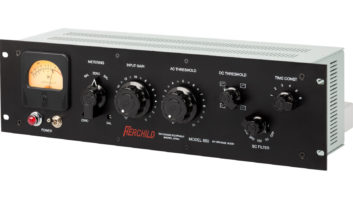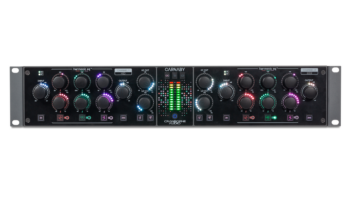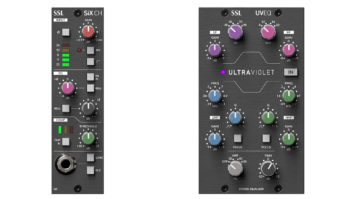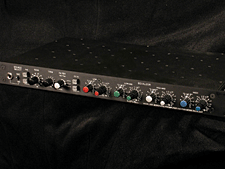
Some two centuries ago, German author and philosopher Goethe said, “Excellence is rarely found, more rarely valued.” It’s clear that his quote needs an update, because Goethe never used any products from GML Labs, whose latest excellent effort is the Model 2032 single-channel mic preamp/equalizer.
The unit borrows heavily from the 8200 EQ that’s ubiquitous in high-end studios and GML’s super-clean 8300 mic preamp. Like its forefathers, the 2032 features a transformerless, electronically balanced, Class-A signal path. However, it differs from its predecessors with its internal power supply — a first for GML — and the addition of brightly lit polarity and phantom power switches. The latter is a welcome confidence-builder for ribbon mic users.
As a bonus, the front panel includes a ¼-inch unbalanced hi-Z instrument input (1 megohm), which can be selected using the mic/MI switch. The preamp provides up to 75 dB of clean gain using a knob that steps between 15 dB and 70 dB in 5dB increments, plus a trim pot with ±5 dB of continuously variable gain. The filter switch has three positions: flat or a choice of second-order (-12dB/octave roll-off) Butterworth highpass filters at 40 Hz or 100 Hz.
The EQ will be familiar in sound, look and feel to anyone who’s used the 8200 EQ. The 4-band fully parametric EQ is broken into lows, low-mids, high-mids and highs, with the outer bands offering shelving functions when turned fully counterclockwise. Up to ±15 dB of gain is available on each band via the gain pot. A dual-concentric knob offers overlapping frequency choices, and Q (bandwidth) control, which is variable from 0.4 to 4 octaves.
The front panel also has a power LED indicator and an overload LED that monitors the preamp and EQ outputs and is set just below clipping at +24 dBu. (The actual clipping point, as determined by 0.1% THD+N, is 27 dBu; so there is a minimum of 3 dB of additional headroom beyond the clipping indicator.) The back of the unit has an IEC socket, fuse holder, 110/220V selector and I/Os for the main signal path and insert. A ground block offers separate bridged paths for the electronics and chassis. The Insert Out jack carries the mic preamp out post-filter. With the Insert button engaged on the front panel, the Insert In routes input to the EQ, while the main output carries its output. As an aside, the XLR input can handle line sources, provided that the device can drive the 1k-ohm load impedance.
IN YOUR EAR
My first 2032 session involved EQing a bass track. Selecting 100 Hz and turning it up rounded out the instrument nicely and was instant love. The bottom end was warm and the Q control let me precisely sculpt the bass to the track. Next, I used the 2032 as a DI and was pleased with the outcome. The bass was clean and it was nice knowing that I could tweak a band or two if I needed it. The bass guitar had active electronics with a hot output, but the 2032 handled the signal without a problem.
This unit is made for vocal tracking. I used it with both a U87 and a BLUE Bottle mic with superb results. Paired with an excellent mic, the 2032 makes vocal tracking a breeze, offering ample clean gain and the ability to add any kind of presence, low or high end, that I needed.
Next, I used the unit paired with a DPA 4061 for miking a snare drum and later the top of a tom. The DPA is very open by nature and juicing it with the 2032 made for an excellent combo for drum recording. Later, I tried it for recording percussion, acoustic guitar, guitar amp, sax and mono piano, all with excellent results.
OUT THE DOOR
Warning: The 2032 can be habit-forming with continued use, resulting in the desire to have more. In short, this unit is a monster. The preamp is exceedingly open and clean, provides plenty of gain and the integral power supply is brilliant. (Anyone who has ever lost the multipin XLR external supply cable from past GML efforts knows what I’m talking about.) The unit’s fit and finish is excellent. The knobs and switches are solid; screening is clear and easy to read. Despite squeezing a lot of functionality into a single rackspace, the layout is spacious and comfortable.
Sonically, the 2032 exceeds any expectations you’d have about a mic preamp and EQ. The ability to separate the preamp/EQ functions makes it a tracking and mixing tour de force, giving the user a great preamp, killer DI and four bands of excellent fully parametric EQ. Quality doesn’t come cheap, but when you add up all the parts and functionality, this unit is a bargain at $3,000 retail. If you are looking for an excellent front-end preamp/DI, plus an EQ that is one of the best around, give the GML 2032 a listen.
George Massenburg Labs, 615/790-1016, www.massenburg.com.
Kevin Becka is Mix’s technical editor.


